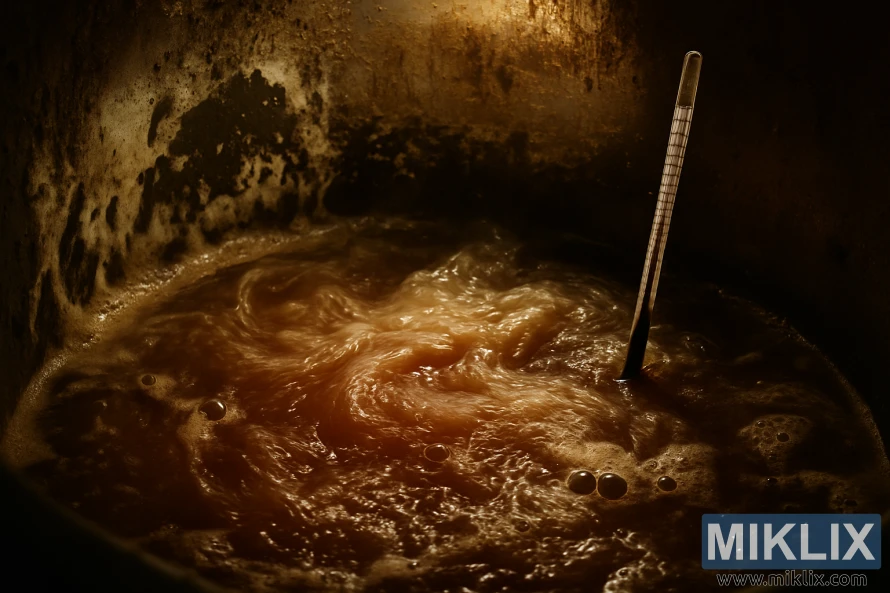Image: Troubled Fermentation Tank Interior
Published: July 24, 2025 at 7:39:25 AM UTC
Last updated: September 27, 2025 at 10:02:32 PM UTC
Swirling, hazy liquid in a dim tank with foamy residue and elevated temperature signals possible yeast stress.
This image presents a raw, unfiltered glimpse into the interior of a fermentation vessel, capturing a moment where the process appears to be veering off course. The scene is dimly lit, with warm, almost amber tones casting a moody glow across the metallic walls of the tank. At the center, a swirling, turbulent liquid churns with visible agitation. The color of the liquid—a murky orange-brown—suggests a mixture of wort and suspended solids, but its haziness and uneven texture hint at something more troubling. Bubbles rise erratically, forming patches of foam that cling to the tank’s inner surface in irregular, off-colored streaks. These residues, tinged with gray and pale yellow, suggest the presence of stressed yeast or possible microbial contamination, a visual cue that something within the fermentation process is not behaving as expected.
The lighting, though warm, is harsh and directional, casting dramatic shadows that exaggerate the unevenness of the liquid’s surface and the residue along the walls. This interplay of light and shadow creates a sense of tension, as if the tank itself is under scrutiny. The foam lacks the uniformity and brightness typical of healthy fermentation, instead appearing fragmented and discolored, with pockets of dense froth interspersed with thin, oily patches. These visual anomalies may point to temperature stress, oxygen exposure, or the intrusion of wild yeast or bacteria—each capable of derailing the delicate balance required for clean, controlled fermentation.
In the foreground, a thermometer protrudes from the liquid, its metallic stem catching the light and drawing attention to the digital readout. The temperature displayed is slightly elevated, hovering above the optimal range for ale yeast fermentation. This subtle detail adds another layer of concern, suggesting that the yeast may be operating under thermal stress, which can lead to the production of unwanted esters, fusel alcohols, or stalled fermentation. The thermometer’s presence is a reminder of the brewer’s vigilance, a tool meant to safeguard the process, now serving as a silent witness to its potential unraveling.
The background fades into soft blur, with hints of additional brewing equipment barely visible—perhaps other tanks, pipes, or control panels. This lack of clarity reinforces the isolation of the troubled vessel, focusing the viewer’s attention on the swirling liquid and the signs of distress within. The overall composition is tight and intimate, almost claustrophobic, emphasizing the immediacy of the issue and the need for intervention. It’s a scene that speaks to the fragility of fermentation, where even minor deviations in temperature, sanitation, or yeast health can cascade into significant problems.
Altogether, the image conveys a mood of unease and urgency. It is a portrait of fermentation in flux, where the promise of transformation is threatened by instability. Through its lighting, texture, and detail, the image invites the viewer to consider the complexities of microbial life and the precision required to guide it successfully. It is a reminder that brewing is not just a craft but a constant negotiation with living organisms—one that demands attention, adaptability, and respect.
The image is related to: Fermenting Beer with Mangrove Jack's M36 Liberty Bell Ale Yeast

